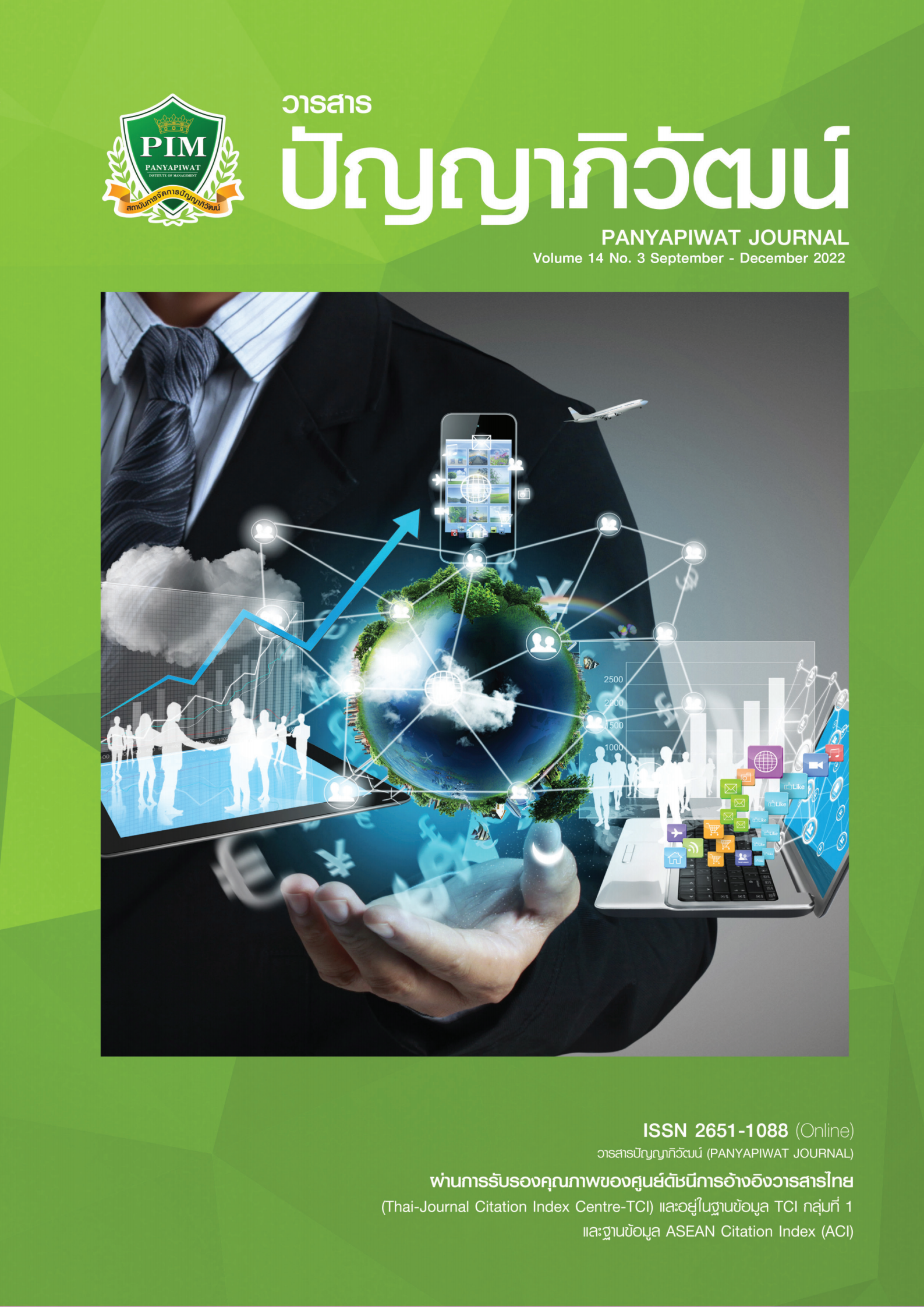การศึกษากลุ่มเสี่ยงและปัจจัยปกป้องพฤติกรรมการติดสมาร์ทโฟนของนักศึกษาระดับปริญญาตรี สถาบันระดับอุดมศึกษาเอกชน ในเขตกรุงเทพมหานครและปริมณฑล
Main Article Content
บทคัดย่อ
การวิจัยนี้มีวัตถุประสงค์เพื่อศึกษากลุ่มเสี่ยงและปัจจัยปกป้องพฤติกรรมการติดสมาร์ทโฟนของนักศึกษา กลุ่มตัวอย่างที่ใช้ในการวิจัยครั้งนี้เป็นนักศึกษาที่กำลังศึกษาระดับปริญญาตรี สถาบันระดับอุดมศึกษาเอกชนในเขตกรุงเทพมหานคร และเขตปริมณฑล โดยใช้การสุ่มตัวอย่างแบบเจาะจง (Purposive Sampling) รวม 400 คน เครื่องมือที่ใช้ในการเก็บรวบรวมข้อมูลโดยใช้แบบวัดตัวแปรเชิงสาเหตุและผลของพฤติกรรมการติดสมาร์ทโฟน จำนวน 7 แบบวัด และมีค่าความเชื่อมั่นตั้งแต่ .88 ถึง .95 ทำการเก็บข้อมูลระหว่างวันที่ 25 กุมภาพันธ์ ถึงวันที่ 30 เมษายน 2565 วิเคราะห์ข้อมูลด้วยการวิเคราะห์ t-test ความแปรปรวนแบบทางเดียว(One-way analysis of variance) และการวิเคราะห์ถดถอยพหุคูณแบบเป็นขั้น (Stepwise Multiple Regression)
ผลการศึกษากลุ่มเสี่ยงพบว่า นักศึกษาชั้นปีที่ 1 เป็นผู้ที่มีการติดสมาร์ทโฟนน้อยกว่านักศึกษาชั้นปีที่ 2-4 อย่างมีนัยสำคัญทางสถิติที่ระดับ .05 โดยนักศึกษาชั้นปีที่ 2-4 เป็นผู้ที่มีพฤติกรรมการติดสมาร์ทโฟนไม่แตกต่างกัน ปัจจัยที่เป็นตัวทำนายพฤติกรรมการติดสมาร์ทโฟนของนักศึกษาที่สำคัญมี 2 ปัจจัยเรียงจากมากไปน้อย คือ ความเหงา และค่านิยมแบบวัตถุนิยม มีค่าการพยากรณ์ของพฤติกรรมการติดสมาร์ทโฟนของนักศึกษาระดับปริญญาตรีเท่ากับ 0.48 กล่าวคือ ทั้งสองปัจจัยสามารถร่วมกันอธิบายความแปรปรวนของการติดสมาร์ทโฟนของนักศึกษาระดับปริญญาตรี ได้ร้อยละ 48 อย่างมีนัยสำคัญทางสถิติที่ระดับ .05 โดยนักศึกษาที่เป็นกลุ่มเสี่ยงเร่งด่วนที่ควรพัฒนาคือ นักศึกษาที่มีพฤติกรรมพฤติกรรมการติดสมาร์ทโฟนมาก ได้แก่ กลุ่มนักศึกษาชั้นปีที่ 2-4 โดยมีปัจจัยปกป้องที่สำคัญ ได้แก่ ความเหงา และค่านิยมแบบวัตถุนิยม
Article Details

อนุญาตภายใต้เงื่อนไข Creative Commons Attribution-NonCommercial-NoDerivatives 4.0 International License.
“ข้าพเจ้าและผู้เขียนร่วม (ถ้ามี) ขอรับรองว่า บทความที่เสนอมานี้ยังไม่เคยได้รับการตีพิมพ์และไม่ได้อยู่ระหว่างกระบวนการพิจารณาลงตีพิมพ์ในวารสารหรือแหล่งเผยแพร่อื่นใด ข้าพเจ้าและผู้เขียนร่วมยอมรับหลักเกณฑ์การพิจารณาต้นฉบับ ทั้งยินยอมให้กองบรรณาธิการมีสิทธิ์พิจารณาและตรวจแก้ต้นฉบับได้ตามที่เห็นสมควร พร้อมนี้ขอมอบลิขสิทธิ์บทความที่ได้รับการตีพิมพ์ให้แก่สถาบันการจัดการปัญญาภิวัฒน์หากมีการฟ้องร้องเรื่องการละเมิดลิขสิทธิ์เกี่ยวกับภาพ กราฟ ข้อความส่วนใดส่วนหนึ่งและ/หรือข้อคิดเห็นที่ปรากฏในบทความข้าพเจ้าและผู้เขียนร่วมยินยอมรับผิดชอบแต่เพียงฝ่ายเดียว”
เอกสารอ้างอิง
Bhanthumnavin, D. (2009). Principles and methods of document processing for excellence in behavioral research (2nd ed.). AA Public Company. [in Thai]
Bolle, C. (2014). “Who is a smartphone addict?” The impact of personal factors and type of usage on smartphone addiction in a Dutch population. University of Twente.
Carbonell, X., Oberst, U., & Beranuy, M. (2013). The cell phone in the twenty-first century: A risk for addiction or a necessary tool? In Principles of addiction: Comprehensive addictive behaviors and disorder (pp. 901-909). Academic Press.
Chansiri, P. (2019). Game addiction, a threat to the health of Thai children that parents have to take care of and protect. Chulalongkorn Hospital. https://chulalongkornhospital.go.th/kcmh/โรคติดเกม/ [in Thai]
Electronic Transactions Development Agency. (2019). Report of the survey results of internet users in Thailand in 2018. Office of Strategy, Electronics Transactions Development Agency. [in Thai]
Griffiths, M. D. (2005). A ‘components’ model of addiction within a biopsychosocial framework. Journal of Substance Use, 10, 191-197.
Hair Jr., J. F., Black, W. C., Babin, B. J., & Anderson, R. F. (2010). Multivariate data analysis: A global perspective (7th ed.). Prentice-Hall.
Homthuanlom, A. (2019). Factors affecting decision to play online game on mobile phone of people [Master’s thesis]. Siam University.[in Thai]
Jun, S. (2016). The reciprocal longitudinal relationships between mobile phone addiction and depressive symptoms among Korean adolescents. Computers in Human Behavior, 58, 179-186.
Krajangprateep, S. (2013). Family relationships, loneliness, self esteem, and internet use among students of Thammasat University [Master’s thesis]. Thammasat University. [in Thai]
Lee, Y. K., Chang, C. T., & Cheng, Z. H. (2014). The dark side of smartphone usage: Psychological trait, compulsive behavior, and technostress. Computers in Human Behavior, 31(1), 373-383.
Magnusson, D., & Endler, N. S. (1977). Personality at the crossroad: Current Issues in interactionism psychology. LEA Publishers.
National Statistical Office. (2020). Survey on the use of information technology in households in 2021. http://www.nso.go.th/sites/2014/Pages/home.aspx [in Thai]
Peplau, L. A., & Perlman, D. (1982). Loneliness: A sourcebook of current theory. Research and Therapy. John Wiley & Sons.
Petprayoon, C. (2017). Causal model of smartphone addiction among undergraduate students in Bangkok [Doctoral dissertation]. Srinakharinwirot University. [in Thai]
Richin, M. L., & Dawson, S. (1992). A consumer value orientation for materialism and its measurement: Scale development and validation. Journal of Consumer Research, (19), 303-316.
Roberts, J. A., Pullig, C., & Manolis, C. (2015). I need my smartphone: A hierarchical model of personality and cell-phone addiction. Personality and Individual Differences, 79(2015), 13-19.
Rojanahasadin, A. (2019). Dorm Children and 1st year students are at high risk of depression stress, stress, and kill yourself. Dailynews.co.th. http://d.dailynews.co.th/education/743054/ [in Thai]
Saiyot, L., & Saiyot, A. (1985). Principles of educational research. Suksaporn. [in Thai]
Schermerhorn, J. R. (1997). Organizational behavior. John Wiley & Sons, Inc.
Silangam, P. (2018). Dangers of smartphone addiction. HCU Journal of Health Science, 22(43-44), 193-204. [in Thai]
Tan, C., Pamuk, M., & Donder, A. (2013). Loneliness and mobile phone. Procedia Social and Behavioral Sciences, 103(1), 606-611. http://doi:10.1016/j.sbspro.2013.10.378
Tindell, D. R., & Bohlander, R. W. (2012). The use and abuse of cell phones and text messaging in the classroom: A survey of college students. College Teaching, 60(1), 1-9.
Thongjuerpong, P. (2016). Factors and effects of smart phone addiction to job performance nomo-phobia and conflict with others. JSB Journal, 2(3), 40-54. [in Thai]
Thomee, S., Harenstam, A., & Hagbrrg, M. (2011). Mobile phone use and stress, sleep disturbances and symptoms of depression among young adults-a prospective cohort study. BMC Public Health, 11(66), 1-11.
Vora, L. J. (2015). Evolution of mobile generation technology: 1G to 5G and review of upcoming wireless technology 5G. International Journal of Modern Trends in Engineering and Research, 2(10), 281-290.
Wang D., Xiang Z., & Fesenmaier, D. R. (2016). Smartphone use in everyday life and travel. Journal of Travel Research, 55(1), 52-63.
Watananukul, P., Pewkom, W., & Chansawang, P. (2017). Behavior and factors of smartphone usage among adolescents. http://sc2.kku.ac.th/stat/statweb/images/Eventpic/60/Seminar/01_6_.pdf [in Thai]
Weiss, R. S. (1973). Loneliness: The experience of emotional and social isolation. MIT Press.
Young, K. S. (1999). The evaluation and treatment of Internet addiction. In L. V. Creek, & T. Jackson (Eds.), Innovations in clinical practice: A source book (pp. 17, 19-31). Professional Resource Press.


